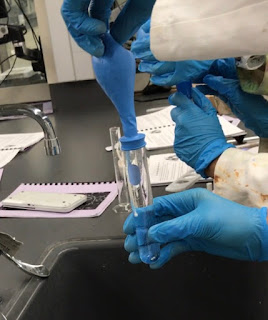Lab 15: Evaporation and Intermolecular Attractions
Evaporation and Intermolecular Attractions
Introduction:
The purpose of this lab was to observe how different intermolecular forces and molar masses have an impact on evaporation of different molecules. We tested this by using several different samples on temperature probes and seeing how the temperature changed over a 4 minute period. Each sample had a difference in either molar mass or intermolecular force.
Pre-Lab Table:
Data:
Conclusion/Questions:
Overall, this lab was fairly successful because we were able to quickly complete the procedure with clear results. We didn't really have any challenges or problems during our lab and everything was fairly straight forward.
2. Explain the differences in the difference in temperature of these substances as they evaporated. Explain your results in terms of intermolecular forces.
The differences of the 5 substances varied quite a bit but they were almost all decreasing except for glycerin. The reason they were different was because they all had difference in intermolecular forces. Methanol had the lowest because it is smaller than the other molecules and it only has one area to attract to other molecules compared to water or glycerin meaning that it had a very weak intermolecular force making it easy to evaporate. N-Butanol had the smallest drop in temperature because it was the largest molecule with only one point in the structure to hydrogen bond with other molecules making it the molecule with the second most intermolecular force. Glycerin surprisingly had an increase in temperature most likely because it had three total places to hydrogen bond making its intermolecular force very strong and hard to evaporate. Also, since all of the given molecules were somewhere polar with a hydrogen and oxygen, they could all hydrogen bond so the type of bonding wasn't an issue with finding which one had the strongest intermolecular force.
3. Explain the difference in evaporation of any two compounds that have similar molar masses. Explain your results in terms of intermolecular forces.
Two molecules with sort of similar molar masses were n-Butanol and Glycerin and had very different results during the experiment. The reason their results were different was mostly due to the fact that hey each had different strengths in intermolecular force which is much more important that molar mass. Glycerin had the ability to make three hydrogen bonds making its intermolecular strength very high allowing it to absorb more energy instead of evaporating. N-Butanol, on the other hand only had two areas to have hydrogen bonds making it have a slightly weaker intermolecular force. This allowed glycerin to have the ability to have a raise in temperature and n-butanol to have a drop because the bonds in n-butanol were much easier to break compared to glycerin's.
4. Explain how the number of -OH groups in the substances tested affects the ability of the tested compounds to evaporate. Explain your results in terms of intermolecular forces.
The number of -OH groups in the substances test affects the ability of the tested compounds to evaporate because the more -OH groups means it can make more hydrogen bonds. This is very important because if a molecule and make more hydrogen bonds, it can connect to more molecules strengthening their intermolecular force as a whole. When any substance has a very high intermolecular force, it is much harder to boil/evaporate because the molecules will stick together and not break apart. For example, Methanol and just normal water had much different changes in temperature and even though methanol has a higher molar mass than water, water has the ability to make two hydrogen bonds because of the H's on both ends, whereas methanol can only make one hydrogen bond. This allows water to stick together and not evaporate as quickly. Using this you can observe that the molecules with more -OH groups can have stronger intermolecular forces as long as they have relatively similar molar masses.
Two molecules with sort of similar molar masses were n-Butanol and Glycerin and had very different results during the experiment. The reason their results were different was mostly due to the fact that hey each had different strengths in intermolecular force which is much more important that molar mass. Glycerin had the ability to make three hydrogen bonds making its intermolecular strength very high allowing it to absorb more energy instead of evaporating. N-Butanol, on the other hand only had two areas to have hydrogen bonds making it have a slightly weaker intermolecular force. This allowed glycerin to have the ability to have a raise in temperature and n-butanol to have a drop because the bonds in n-butanol were much easier to break compared to glycerin's.
4. Explain how the number of -OH groups in the substances tested affects the ability of the tested compounds to evaporate. Explain your results in terms of intermolecular forces.
The number of -OH groups in the substances test affects the ability of the tested compounds to evaporate because the more -OH groups means it can make more hydrogen bonds. This is very important because if a molecule and make more hydrogen bonds, it can connect to more molecules strengthening their intermolecular force as a whole. When any substance has a very high intermolecular force, it is much harder to boil/evaporate because the molecules will stick together and not break apart. For example, Methanol and just normal water had much different changes in temperature and even though methanol has a higher molar mass than water, water has the ability to make two hydrogen bonds because of the H's on both ends, whereas methanol can only make one hydrogen bond. This allows water to stick together and not evaporate as quickly. Using this you can observe that the molecules with more -OH groups can have stronger intermolecular forces as long as they have relatively similar molar masses.





Comments
Post a Comment